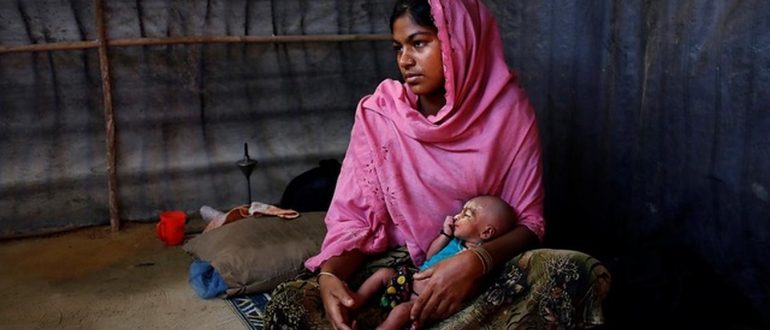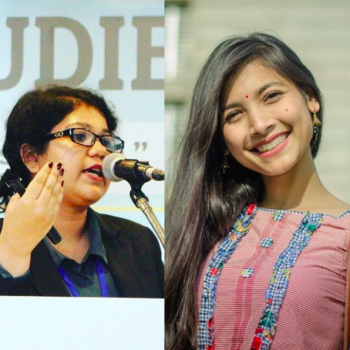
Another View at the Rohingya Crisis: Women Stuck in the Barriers of Stigma
‘The crisis situation disproportionately affects women, girls, and the most vulnerable and marginalized Rohingya refugee population groups by reinforcing, perpetuating, exacerbating pre-existing, persistent gender inequalities, gender-based violence, and discrimination.’ – UN Women
More than 700,000 people of the persecuted Rohingya minority of Myanmar have fled to neighboring Bangladesh following the military crackdown launched against them in August of 2017. Housing temporarily in the Bangladeshi south-eastern region of Cox’s Bazar, along with previously dwelling Rohingya refugees, the region is now home to over nine hundred thousand Rohingya refugees. The overcrowded refugee camps in the region is the biggest refugee camp in the entire world. Approximately 52% of the people there are females, who are persistently vulnerable to harassment and exploitation, coupled with stigma.
Many of the women crossed the border alone and in a lot of the cases with little children. Despite having fled their persecution, Rohingya women and girls face additional threats: violence, vulnerability to abuse, limited mobility, human trafficking, harassment, and suppression of their speech in their communities. Access to humanitarian assistance and certainty of their rights within the camps are highly influenced by cultural norms and societal habits within the community. Absence of institutions, inadequacy of the ones that exist and the lack of implementation due to a variety of reasons is just one of the imaginable reasons for gender gaps. Other elements of psychosocial challenges include the issues surrounding psychosomatic characteristics of women due to past trauma and stigma within the community.
Women in a crisis: Caught in a Limbo
In 2007, Pittway described the horrendous situation of the two registered Rohingya refugee camps in Nayapara and Kutupalong. “In 30 years in the field, I have never before been in an established camp where the fear was so palpable and pervasive and where malnutrition and poverty was so rife. Corruption, rape, sexual abuse, abductions, trafficking, organized prostitution, including of children, ration fraud and a systematized regime of terror has left a population of at least 26,000 refugees in a state of trauma and with little or no hope for the future. I have never seen so many ‘sexualized’ children. Deaths from malnutrition and untreated medical conditions are common. These refugees have been living in the camps for up to 15 years.”[1] At that time, the improvised refugee camps, where the refugees had been living since the mid-1970s, were described as one of the worst in the world, with little aid, constant violence, and exploitation. One characteristic of the camps was gender-specific violence.
According to Pittway, girls as young as nine years of age were abducted and married by locals. Child prostitution was encouraged within the camps, while women and girls were also trafficked into the nearby sex markets in the city. It was reported that some were abducted by local police, military, and civilians and that children of rape are being aborted in unhealthy and life-threatening manners in the camps.
Twelve years later, little has changed. Even though there have been significant improvements in the provision of rations, institutions as well as other services in the refugee camps, the causes of insecurity persist. In a news report by International Organization for Migration (IOM) security of women was named to be the one of the most pressing issue in the camps right now, particularly due to cases of kidnapping and that the lack of sufficient electricity in the camps makes the area more vulnerable to abductors and traffickers at night. More personal impediments for refugee women are categorized into two main tendencies: First, the past stigma and refusal, which records the misery and rejection of the past traumas of the Rohingya women by themselves; second, psychosomatic impacts, which highlights the issue of a high degree of mental health problems due to past and present oppressions they have faced; third, there is much contention regarding capacities and participations.
i. The Past, Stigma and Refusal
‘Widespread sexual violence perpetrated by Myanmar military soldiers has been a hallmark of the culture of abuse and impunity in Burma’s decades-long civil war with its ethnic groups, the Rohingya.’ – Human Rights Watch
In May of 2018, it was reported that almost every woman and girl has experienced “patterns of rape, gang rape, forced nudity and abduction for the purpose of sexual slavery during military campaigns of slaughter, looting and the razing of homes and villages.” As a result, UN officials estimated in mid-2018 that there were about 40,000 pregnant Rohingya women ready to give birth. NGOs have since made efforts to find women and young girls to ensure healthy births. “The stigma of a pregnancy as a result of rape makes it very hard for [women] to come out openly with the fact of their pregnancy,” as it was put by the Special Representative of the UN Secretary-General on Sexual Violence in Conflict, Pramila Patten. The socio-economic consequences coupled with a lifetime of psychosomatic impacts coupled with stigma, scar the women and children of rape[2].
ii. Psychosomatic Impacts
The women are vulnerable to a wide range of mental health issues such as post-traumatic stress disorder, anxiety, and depression. Issues of concern within the emergency and post-emergency operation in Bangladesh include the high rates of sexual and gender-based violence, lack of privacy and safe spaces and limited access to integrated psychosocial and mental health support remain issues of concern. Studies show high levels of symptoms of posttraumatic stress disorder (PTSD) (36%) and depression (89%) in the refugee camps of Kutupalong and Nayapara.
Suicidal thoughts are reportedly common among the Rohingya people in the refugee camps and elsewhere. This is linked to the strong sense of hopelessness due to displacement and unpromising prospects for the future. As Islam prohibits suicide, women refuse to express their suicidal thoughts to family and friends. According to a report by IOM, 62% of women with young children expressed suicidal thoughts in 2018. More consequences include visual or auditory hallucinations, psychoses, and manic states. Other than that, women have also reported emotional distress and burning sensations.
iii. Institutions & Participants: Are They on the Same Page?
The antenatal and postnatal period of motherhood are critical periods for both the mother and the baby. To guide them through these important times, not only healthcare centers, but also nutrition centers set up by various NGOs play an essential role in maintaining the healthy lifestyle of women and children. However, despite being in place around the refugee camps, many women prefer to not take advantage of these institutions. Instead, they often opt for home births as opposed to giving birth at medical centers based on traditional reasons and pressure from their community.
Their reluctance to seek formal mental health assistance is the limited understanding of concepts of mental health and counseling or knowledge of where to seek services. Due to the lack of education and awareness regarding mental health issues, the Rohingya community has a low familiarity with the importance of such a burning issue. With religious roots being at the center of support and strength for the Rohingya people, reserving to traditional healers is a prevalent tendency within the refugee camps. As with physical health, the women also prefer not seeking established medical assistance when it comes to mental health as traditional healing methods play an essential role in Rohingya culture. One must also keep in mind the limited number of female refugees who do seek this informal, more customary form of assistance.
Concluding Remarks and Recommendations: The Future of Rohingya Females in Refugee Camps
Rohingya women are prone to mental frangibility due to past traumatic experience. Due to previously experiencing gender-based discrimination and sexual exploitation, the women in the camps are still in constant fear for their safety and security.
By now, women and girls are provided with various work programs. They are often trained beforehand. For example, Nur Kaidia, an adolescent Rohingya girl, completed her two-month tailoring course at the UN Women-Constructed Multi-Purpose Women Center. And now she can make clothes for herself and her family as well as taking orders from neighbors, there by supporting herself and her family through the skill that she acquired[3]. Other than that, around 295 women are participating in World Vision’s initiative of work. Hamida is one of the women involved in the program; she is breaking the barrier of Rohingya refugees’ conservative Muslim culture and says that, “We don’t care what kind of work we are given. We fill bags with sand and cement, level pathways and weave bamboo fences while men do the heavier work.” Most of the women employed under this program are young widows. The Women Centre also provides women with counseling to develop their psychosocial condition and to strengthen their position in the society. While there have been some stellar progresses made to free the refugee women from the tainted bars of stigma and bring them on their feet, the pace of the progress remains limited, as most have been reached out to, yet only a few have participated.
Image: @Dhaka Tribune
[1] Pittaway, E. “The Rohingya Refugees in Bangladesh: A Failure of the International Protection Regime.” Research Gate, accessed 07 November 2019.
[2] Gender Reflection: Two Years of Rohingya Refugee Response (September 2019) (ReliefWeb, 2019), p. 1, https://reliefweb.int/sites/reliefweb.int/files/resources/gender_reflections_sept19.pdf
[3] Gender in Humanitarian Action Brief No. 5 (July 2018) (Inter Sector Coordination Group, 2018) https://www.humanitarianresponse.info/sites/www.humanitarianresponse.info/files/documents/files/iscg_giha_brief_no._5_gender_equality_interventions_adolescent_rohingya_girls_and_boys_-_final30july2018.pdf

Nahian Salsabeel and Faria Ulfath Leera
Nahian Salsabeel (left) is a young aspirant researcher pursuing her Bachelor of Social Sciences in International Relations at Bangladesh University of Professionals in Bangladesh. Her research interests include fields of migration, gender and development. She has experience in research and fieldwork from having been to the Rohingya refugee camps multiple times in her country as an independent researcher, besides working as a research assistant at Bangladesh Institute of Peace and Security Studies (BIPSS). Her array of publications are inclusive of the fields of migration, identity politics, South Asia, conflict, and so on. Faria Ulfath Leera (right) is currently doing her Bachelor of Social Sciences in International Relations at Bangladesh University of Professionals. She is a Bangladeshi and takes interest in development, environmental issues and international politics. Besides playing role of an executive member in different national college events and competitions, she has working experience as research intern at a think tank in her country as well as publications on contemporary issues in local and international forums.
